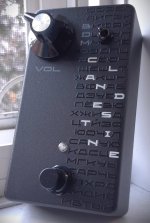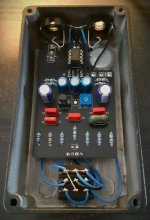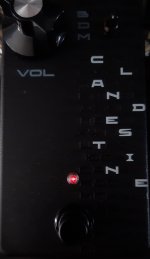Silver Blues
Well-known member
- Build Rating
- 4.00 star(s)
I know that people love this preamp, and have heard from more than one bass player that it is an excellent addition to one's signal chain, so I thought I would take a crack at one as well. This PCB was one of those sitting on my to-do list waiting for graphics inspiration, and it finally hit me, so it jumped up to the front of the queue. Here she is:


Lately I've been watching the TV show Alias, and S01E08 gave me the inspiration for this pedal's graphics:
Anyone who wants to watch the show need not read the spoiler above, but basically the graphics are a play upon a clandestine message, encoded in a cipher of 5-character rows of Cyrillic letters, hidden in ghosted characters. (The Cyrillic here is just random letters for visual effect.) Thanks to @Bricksnbeatles for suggesting rich black with gloss for the ghosted part, it worked amazingly well. The enclosure is Tayda Matte Black Sand with the PPCB-provided drill template for this project, and the UV print was also done by Tayda.
I decided this pedal would look great with blacked-out hardware, so of course I needed to use a regular 3PDT because I can't get black plated soft-touch switches (unfortunately - someone should get on that). I ended up using this switch because I still wanted the soft-touch actuation, as always. It's not bad, better than I was expecting and quite sturdy, but the action is a bit gritty - nowhere near as good as my current favourite the LMS Pro 3PDT, but definitely nothing to complain about. I used some semi-mojo components in here - Philips MPR24 0.1% metal film resistors, Iskra and Nippon Chemi-Con electrolytics, and a Soviet surplus 220pF silver mica. I was going to use Soviet surplus film caps as well, but the ones that I ordered turned out to be extremely massive and would not fit next to each other on the board so I just went with the classic Wimas. I biased the (Tayda, Central Semiconductor) JFET to exactly half supply (10.57V) - if anyone has any suggestions for bias points, I'd be happy to try them, though I think it's nice as is.
Since learning about the latest weirdness with Tayda enclosures, I learned the hard way that I must have one of the newer boxes with the bigger screw posts, which really fucked me up this time. This build is already very tight at the top because of the location of the toggle switch, and I was barely able to shoehorn an NYS229 input jack alongside the PCB (the output jack fit fine). But when I fired it up, I got no signal in bypass, even though I verified that the 3PDT was working correctly. Turns out the input jack tip contact was shorting against the screw post because it was just small enough to fit but with no clearance. The PCB design also means that closed-frame 111X or A-6040 style jacks do not fit. I therefore had to pilfer a couple of Lumberg jacks from the parts pool of another project to fix the issue, hence the wonky output jack ground wiring. That whole process was displeasing and is why I knocked a star off the build rating.
I used one of these neat red-dot LEDs from The Electronic Goldmine as an indicator for this project, but lapsed on the CLR value, and the stock 4K7 makes the indicator extremely dim (and much dimmer than I wanted). At first I was frustrated by this but now I'm thinking it kind of goes with the aesthetic.

So how does it sound? The Clandestine is a really nice sounding tone conditioner and I can see loads of different ways to use it in a signal chain. I wasn't too familiar with the circuit and am not that familiar with the technical realities of the Echoplex, so @alonkka 's description of the knob sweep was very helpful in figuring out how it works (at first I was convinced something was wrong with my build). Definitely pleased with the sound and this one will probably be finding its way into my signal chain semipermanently as well.


Lately I've been watching the TV show Alias, and S01E08 gave me the inspiration for this pedal's graphics:
For those unfamiliar, Alias is a show which follows main character Sydney Bristow, an undercover agent who believes she is working for the CIA but is actually unknowingly working for a crime organization called SD-6. Upon realizing this, she becomes a double agent for the actual CIA to try and bring down SD-6 from the inside - her father is also an undercover agent with the same goal, and they do not have a good relationship. By this episode, Sydney has reason to suspect her father had been involved with the KGB during the Cold War, although he had assured her this is not the case. The episode contains a scene where Sydney is reading a book that used to belong to her mother, given to her mother by her father. In the book, she discovers a hidden message in the margins, written in a cipher consisting of 5-character rows of Cyrillic letters, which of course puts the suspicion about her father back to the forefront.
Anyone who wants to watch the show need not read the spoiler above, but basically the graphics are a play upon a clandestine message, encoded in a cipher of 5-character rows of Cyrillic letters, hidden in ghosted characters. (The Cyrillic here is just random letters for visual effect.) Thanks to @Bricksnbeatles for suggesting rich black with gloss for the ghosted part, it worked amazingly well. The enclosure is Tayda Matte Black Sand with the PPCB-provided drill template for this project, and the UV print was also done by Tayda.
I decided this pedal would look great with blacked-out hardware, so of course I needed to use a regular 3PDT because I can't get black plated soft-touch switches (unfortunately - someone should get on that). I ended up using this switch because I still wanted the soft-touch actuation, as always. It's not bad, better than I was expecting and quite sturdy, but the action is a bit gritty - nowhere near as good as my current favourite the LMS Pro 3PDT, but definitely nothing to complain about. I used some semi-mojo components in here - Philips MPR24 0.1% metal film resistors, Iskra and Nippon Chemi-Con electrolytics, and a Soviet surplus 220pF silver mica. I was going to use Soviet surplus film caps as well, but the ones that I ordered turned out to be extremely massive and would not fit next to each other on the board so I just went with the classic Wimas. I biased the (Tayda, Central Semiconductor) JFET to exactly half supply (10.57V) - if anyone has any suggestions for bias points, I'd be happy to try them, though I think it's nice as is.
Since learning about the latest weirdness with Tayda enclosures, I learned the hard way that I must have one of the newer boxes with the bigger screw posts, which really fucked me up this time. This build is already very tight at the top because of the location of the toggle switch, and I was barely able to shoehorn an NYS229 input jack alongside the PCB (the output jack fit fine). But when I fired it up, I got no signal in bypass, even though I verified that the 3PDT was working correctly. Turns out the input jack tip contact was shorting against the screw post because it was just small enough to fit but with no clearance. The PCB design also means that closed-frame 111X or A-6040 style jacks do not fit. I therefore had to pilfer a couple of Lumberg jacks from the parts pool of another project to fix the issue, hence the wonky output jack ground wiring. That whole process was displeasing and is why I knocked a star off the build rating.
I used one of these neat red-dot LEDs from The Electronic Goldmine as an indicator for this project, but lapsed on the CLR value, and the stock 4K7 makes the indicator extremely dim (and much dimmer than I wanted). At first I was frustrated by this but now I'm thinking it kind of goes with the aesthetic.

So how does it sound? The Clandestine is a really nice sounding tone conditioner and I can see loads of different ways to use it in a signal chain. I wasn't too familiar with the circuit and am not that familiar with the technical realities of the Echoplex, so @alonkka 's description of the knob sweep was very helpful in figuring out how it works (at first I was convinced something was wrong with my build). Definitely pleased with the sound and this one will probably be finding its way into my signal chain semipermanently as well.

